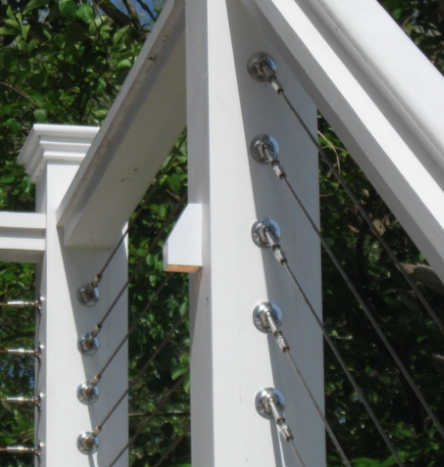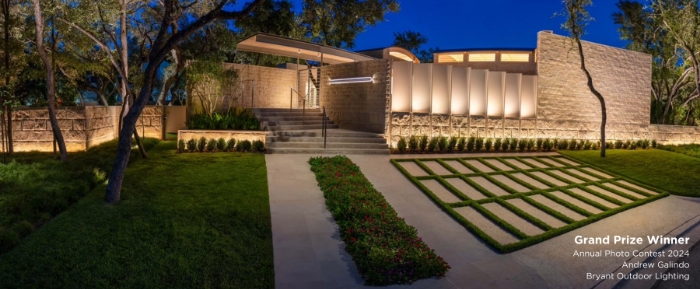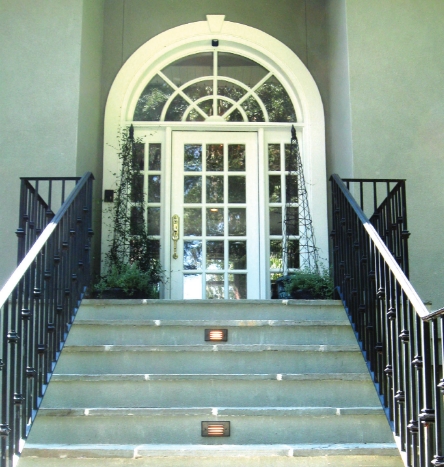Today’s lighting systems are smarter, provide more ambience and safety, and can be seamlessly integrated into patios, pathways and landscaping.
“LED energy-efficient lighting sources are now state of the art,” notes Michael Deo, founder and lead designer for New Jersey-based NatureScape Lighting. “Very few designers are going backward to incandescent sources, unless it’s for a very specific reason, particularly in the low-voltage world.”
When LEDs emerged about a dozen years ago, most designers still used incandescent sources such as halogen, weaving LED in as solutions for specialized applications, whereas today it’s the opposite, Deo adds.
“The vast majority are using LED of different formats, only using incandescent or halogen in very specialized applications or to achieve an old school look,” Deo says.
Other emerging outdoor lighting trends include the integration of controls with numerous applications like brightening and dimming, he adds.
Color and fixture trends
The RGB (red, green, blue) color code has grown “leaps and bounds,” notes Deo. “It’s particularly useful in commercial lighting for branding. You’ll see Hilton Hotels lit up in green. Certain Marriott Hotels are illuminated in a color for their particular branding. Commercial banks like Chase are always blue.”
Additionally, colored LED lights are used for thematic design, such as for holidays. Deo notes a local florist has color-changing LEDs adjusted for each promoted holiday.
In residential applications, people are installing permanent or semi-permanent LED lighting with color-changing capability so they’re not out hanging lights on the roof for every holiday or special event for which they want to illuminate with color, says Deo.
Chris Fry, CIC, CIT, CLVLT, and owner of Irrigation & Lighting Specialties in Charleston, South Carolina, notes use of the RGBW (red, green, blue, white) color wheel has become a trend in certain applications such as commercial spaces and areas of the South and West Coast.

Another trend first developed for interior application and moving to outdoor spaces: computerized control enabling an LED to emulate a very warm tone resembling candlelight and border on the amber side of the color spectrum, or a cool and crisp or neutral light leaning toward the spectrum’s bluish side, Deo says.
High-end lighting contractors are utilizing more smaller fixtures to illuminate facets of the customers’ home or business,” notes Kevin Smith, CLVLT, national tech support and training specialist, BrillianceLED in Carefree, Arizona. “Sometimes smaller light sources can pinpoint a structure’s different architectural accents.”
Their use in turret style windows creates a dramatic effect. Smaller fixtures placed in potted trees near a building’s entrance illuminates trees or plants, creating a nice effect framing that entrance, Smith adds.
The use of smart products using Bluetooth, Wi-Fi, secondary Wi-Fi control devices and remote control have come into play quite often, Smith says.
Fry notes connectivity can be an issue, with boosters, repeaters and Nest applications helping. If Wi-Fi controlled fixtures or systems present an issue, “you can always do Bluetooth-controlled fixtures,” Fry says.
Color and Kelvin temperature changing lamps and fixtures also are becoming popular, says Smith, who advises contractors to seek education from a manufacturer’s representatives or technical department for proper instruction before installation.
The use of permanent lighting has mixed reviews, Fry notes, adding while it has its place primarily in commercial applications, sometimes permits and inspections are needed.
“It’s more of a functional lighting system than a beauty maker,” Fry says. “I would always get the customer to get approval from their HOA/POA prior to spending a lot of time on this project.”
Another trend: outdoor lighting systems integrated with a home’s central control system. That entails bringing in an audio-visual expert to help facilitate that, which can be costly, Fry notes.
For energy efficiency, “all of us know LED is the way to go,” says Fry. “This is why the government has instilled it as the No. 1 protocol. Halogens are phased out completely. You can still buy what inventory is left, but after that, it is all LED.”

Ambient ambiance
In terms of ambience, Deo points out outdoor lighting is different according to the application and the intent for individual areas.
“The ambience that we create — while a very important part of the overall lighting design — needs to be tuned to the user as well as to the specific vignette we are trying to create,” he says.
Deo notes a backyard fire pit may be best served with low lighting for a soft and private ambience.
The pool patio — as well as an inground pool — calls for a fair amount of lighting for safety, he adds.
“My outdoor kitchen area — which may be closer to the house — may require a much higher level of lighting while I’m out there grilling or setting up the countertop buffet style so all my guests can come and eat,” Deo says.
Outdoor kitchen lighting needs to have the capacity to be significantly reduced when the cooking is done as to not reflect off of stainless-steel appliances and ruin the ambience on the rest of the patio, he adds.
It’s important to find out how the customer feels about light and what Kelvin temperature makes them feel comfortable, notes Smith.
A best management practice for a comfortable, romantic look is the use of natural lighting effects with downlighting and backlighting, he adds.
Backlighting creates a lot of depth into the property and is calming to the eyes, says Smith, adding many contractors will put this on a separate switch.
“Downlighting will create beautiful pools of light that are also calming to the eye,” he adds. “If the light is mounted up in a tree, the branches can add shadowing effects on the ground, creating some natural drama.”
In creating ambiance, Fry notes it’s key to use lower lumens.
Fry also favors using strip lighting or small downlights under brick coping or downlight from trees to create a moonlight effect without the light source being visible. He notes bistro lights can create “great ambiance for the right crowd — a younger crowd, entertainers.”
Another ambience strategy: installing dimmers on a system, which can be done via Wi-Fi or with manual dimmers, Fry says.
Safety and security
Regarding lighting for safety, Deo notes “most police officers will tell you the house that is well lit is the one that’s going to be least attractive to unwanted visitors.
“We find when we light landscape and architecture around the perimeter of a residential home, we do a much better job with aesthetic lighting than most people can achieve with soffit-mounted overly bright flood or security lights,” he says.
Security lights are typically too bright and don’t do a good job of illuminating dark niches and cover spaces between the landscape and the architecture, Deo notes.
“Our lighting fixtures are propped up close to the foundation. Nobody could scoot in there without being seen,” Deo says, adding it also lends itself better to cameras detecting motion at night.
“A well-designed, aesthetic, comprehensive lighting plan is always going to increase security much better than old school security lights mounted to the roof of your attic.”
Smith notes it’s important to define the customer’s ambient lights sources before designing a system, adding many ambient sources can cause a security issue.
“As humans, we are drawn toward the brightest light source,” he says, noting a George Fleenor photo showing a bright common outdoor lighting fixture on the side of a driveway mounted onto the house wall.

“When the light is covered by the hand in the picture, you actually see a person standing in a gateway,” says Smith. “Momentary blindness caused by these ambient sources can create a security issue.”
Pathway lighting is another security issue, Smith adds.
“We need to illuminate paths so you can see and navigate your way in the night,” he says. “We must always ask the customer how well they see at night. If they don’t see very well, we may need to illuminate the pathway much more intricately than a normal system.
“We must also ask the customer who visits them on a regular basis and how their eyesight is. This allows the contractor to know the detail of lighting the path to create a safe and secure walkway.”
A lower lumen output of low voltage offers security and beauty on residential properties, Fry says.
“Lighting techniques for this is almost endless,” Fry says. “Stair lights, down light onto stairs and paths, path lights for walkways, wall sconces near the front or back doors — think outside the box.”
Deo notes it’s critical, particularly on a new construction job, that lighting designers are part of the design team from the conceptual stage.
“If we want to incorporate certain effects into steps, patio walls or walkways, coming early on for piping, conduits and power distribution” is important months before a shovel breaks ground to achieve desired results, he says.
Meeting customer needs
Smith notes outdoor environments are now an extension of a home’s indoor elements, and it’s critical to visit with customers to determine how they want that flow to go and determine their favorite Kelvin temperature.
“What you like in lighting may not be what they like,” he notes. “Respect that. While there are times your customer may not care or seem to care, you still need to care. Find out as much information as you can from them to create a beautiful system, even if their budget does not allow for a lot of new fixtures. See if you can help them by reusing some of their older fixtures or at least reusing their transformer, provided it’s in good shape and safe.”
Lighting manufacturers’ technicians are always willing to help contractors create the best system, Smith says.





